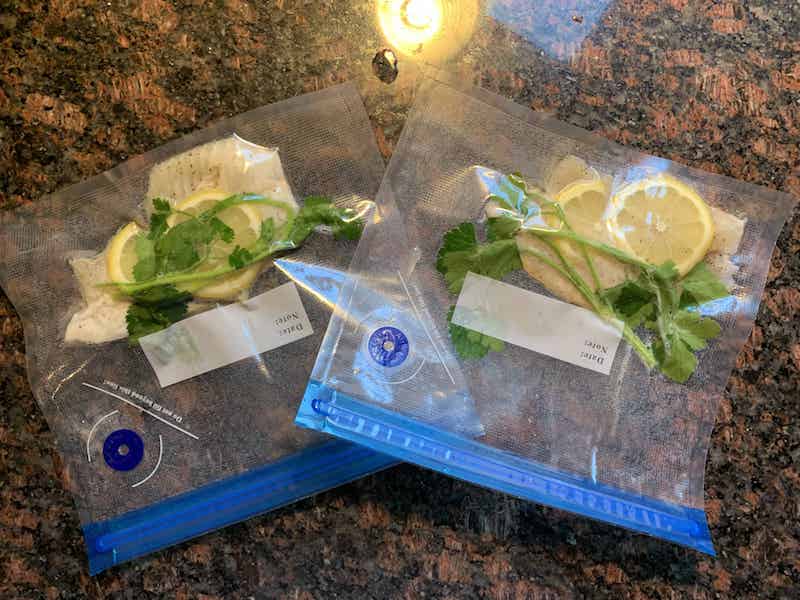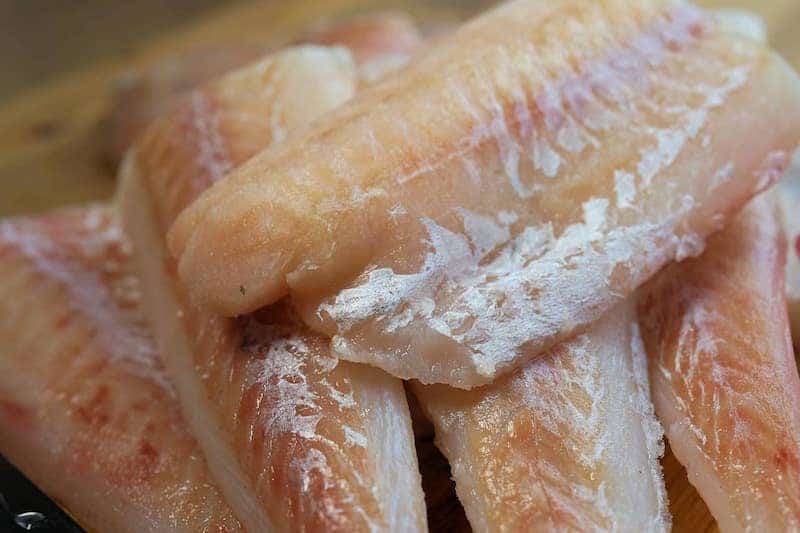Best Fish for Sous Vide
If you’ve never tried sous vide fish, you’re missing out. A lot of people think it’s the best way to prepare it. Nearly any type of fish tastes excellent when cooked sous vide, and you have more control over the final result due to a variety of possible temperature settings.
In this guide, I’ll list the best fish for sous vide, including salmon, halibut, cod, grouper, and tuna. I’ll also explain how to prepare specific fish types using this method. Additionally, I’ll share a couple of tips to help you achieve perfection when cooking fish dishes sous vide.

Is Sous Vide Good for Fish?
Sous vide is one of the best ways you can cook most types of fish. It helps to preserve the flavor and keeps the fish moist, while traditional cooking methods may lead to overcooking. Furthermore, sous vide maintains lower temperatures, thus saving more nutritional elements.
Some safety and preparation tips apply, though. First, it’s recommended to use low temperatures only for fish that you would eat raw, such as salmon. For other varieties, set the temperature above 130°F.
Secondly, brining fish before cooking helps to extract albumin, a protein that often appears on the surface of oven-cooked fish. It isn’t dangerous, but fish without it looks more appealing and has a more vibrant color.
Thirdly, portion your fish before cooking sous vide to improve the heat circulation and stop the fish from falling apart. If you have to put more than one piece of fish in a sous vide bag, make sure they’re positioned side by side and are not on top of each other or overlapping.
Finally, a small amount of butter or oil will prevent fish from changing texture. It’ll also help with removing the fish from the bag more easily once it’s cooked.
When it comes to temperatures, the choice depends on your preference and type of fish.
Generally, the lowest temperature, 104-110°F, doesn’t change the texture much, leaving the fish almost raw.
At temperatures up to 120°F, fish becomes softer yet still remains moist. Temperatures above 120°F and up to 132°F may result in drier fish, but they are great for varieties that require proper heating throughout.
Of course, the preparation time plays a role in the final result too.
Sous Vide Salmon
With salmon, you can use various temperature ranges, which will result in different textures and flavors. As salmon tastes great, both nearly raw and oven-cooked, you may want to try out several recipes until you find the perfect temperature. 115°F can be considered universal, as it makes salmon smooth, slightly flaky, but still moist. For sashimi, set the temperature at 105°F. But if you want the fish cooked throughout, opt for 120-130°F. Don’t use any higher temperatures.
As for the preparation time, salmon may become mushy if you leave it sous vide for too long in low temperatures or too dry if left in high temperatures.
Depending on the size of the slices, half an hour to an hour is enough.
The rules for picking salmon for sous vide are no different from those of other cooking methods:
- Make sure to remove as many bones as possible to prevent the sous vide bag from breaking.
- Brine helps to uncover the flavor, preserve moisture, and improve the texture.
- Adding some butter or oil helps when removing salmon from the bag.
Sous Vide Halibut
Halibut isn’t customarily eaten raw due to its tough connective tissue, so the lowest recommended temperature here is 120°F. At this point, it starts to get soft and layered but remains moist and almost sashimi-like.
130°F is the ultimate temperature for sous vide halibut, as it becomes firm and flaky throughout but tender.
Anywhere above 140°F, and halibut becomes tough and dry – such temperatures are not recommended.
Like with any other fish, the preparation time depends on the portion size. A half-hour to an hour is sufficient.
You can leave the skin on, as it removes easily after halibut has been cooked.
Half an hour is enough to brine halibut.
Sous Vide Cod
Cod is a delicate fish with a flaky texture.
The recommended cod sous vide temperature ranges from between 125°F to 135°F. Regardless of the chosen temperature setting, preparation time is half an hour to an hour, depending on the portions’ size.
Some butter in the bag is desirable. This way, the cod won’t become dry and won’t fall apart when removed from the bag.
You can leave the skin on, but you may want to fry it for a couple of minutes to make it crispy.
Cod is a very versatile fish that can be served with white wine sauce, lemon juice, and a variety of other add-ons.
Sous Vide Grouper
Grouper isn’t much different from salmon in terms of preparation.
Brining it before cooking helps preserve moisture, enhances flavor, and prevents albumin from forming, resulting in a better look.
The lowest recommended temperature is about 110°F if you want to get firm sashimi—the highest – 135°F for a flaky texture. The preparation time typically ranges from half an hour to an hour, though you may have to cook it for even longer in some cases.
Grouper can be served and cooked with various sauces, the simplest (but by no means the least tasty) being lemon-butter dressing.
Sous Vide Tuna
Tuna is often eaten raw and is extremely easy to overcook. Therefore, it’s better to risk setting a lower than a higher temperature. Just like salmon, it can be cooked at 105-130°F during 30-45 minutes.
It’s crucial to only buy tuna from trusted retailers, as this fish may contain mercury.
Brining within half an hour will help to release more flavor, whereas, without brine, tuna cooked at lower temperatures may be slightly bland.
Although, in most cases, a vacuum sealer is better for sous vide than zip lock bags, when it comes to fish, you may want to go for the latter. Removing tuna from a zip lock is much easier, and the pressure inside is lower; thus, your tuna won’t fall apart.
In Summary
My simple recommendations will help prevent overcooking, enhance the flavor, and, most importantly, keep the food safe. Of course, you’re free to decide which texture you prefer and whether you like your fish plain or brined and seasoned.
After trying out several recipes, you’ll likely master sous vide fish at a restaurant level and decide on which is the best fish for you. Remember, it all comes down to the initial product’s quality – select high-quality fish to get the best results.







